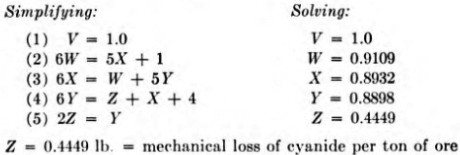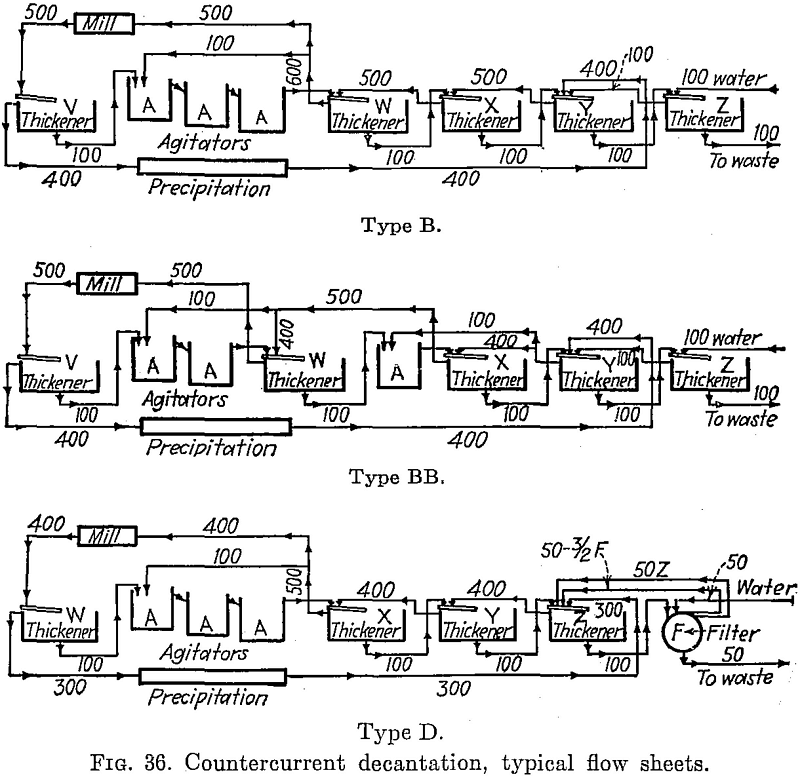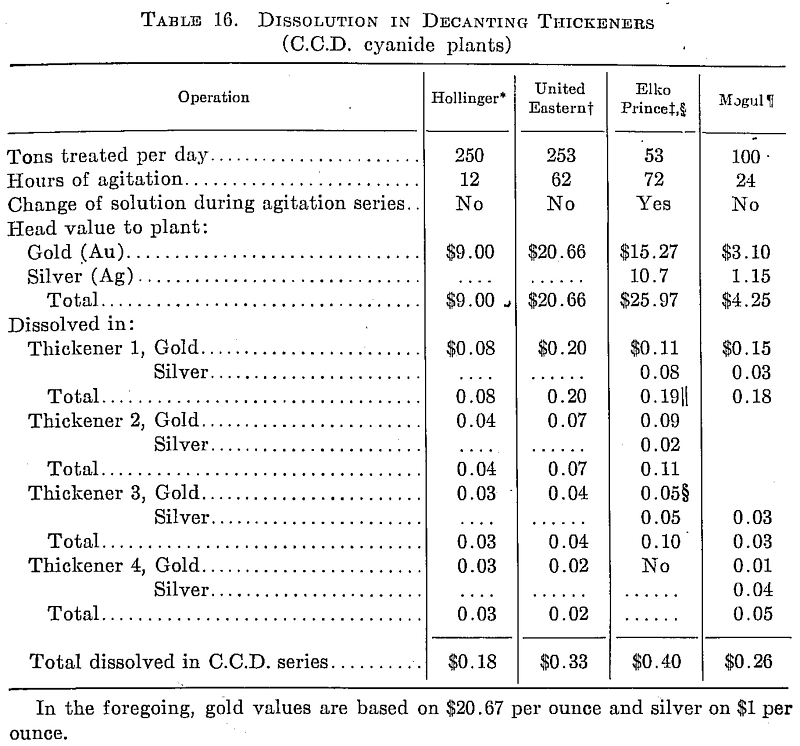Table of Contents
The principle of Counter Current Decantation is simply that, when water or solution is to act upon solids, both are made to pass, in contact, in opposite directions, so that at each end the strongest or most potent portion of either is acting upon the weakest or most exhausted portion of the other.
The recovery of dissolved gold and silver from slime pulp in the cyanide process, as first practiced, employed intermittent decantation.
Attempts to make this process continuous instead of intermittent were made as far back as 1902, but without success. The invention of the Dorr thickener furnished a means of continuous slime settling on a large scale and made the Counter Current Decantation process possible.
Although flow sheets and operation will vary with conditions, the following will give a general idea of the Counter Current Decantation process.
After the ore has been reduced to a uniform fineness by wet grinding and classification and the major portion of the solution removed, it is agitated continuously in a series of about three agitators with cyanide solution, where most of the gold and silver is dissolved. The mixture of solids and solution is fed continuously to the first thickener of the C.C.D. series, consisting of from three to five thickeners. It is diluted with the overflow solution from the next thickener in relatively large quantity, a solution that has already been in contact with the pulp in all succeeding thickeners and so is comparatively rich in dissolved gold and silver.
The overflow from the first thickener of the Counter Current Decantation series containing the greatest amount of dissolved metal is sent to precipitation or to the grinding and classifying circuit. The underflow is pumped to the next thickener, diluted with the overflow from the third of the series, settled and thus proceeds through each thickener, until discharged from the last as tailings. By each step of the system a large amount of low-grade solution is mixed with a very small amount of higher grade solution so that the value of the solution entering each successive thickener is materially reduced. Barren-cyanide solution from the precipitation apparatus is added to the thickener preceding the last and makes up the bulk of the countercurrent flow. Water is added to the last thickener to make up for the liquid losses in the tailing and to cut down cyanide consumption. A thickener called No. 1 precedes the agitators in the mill; therefore the first thickener in the C.C.D. series is usually referred to as No. 2.
Uses. 1. To recover practically all of the dissolved values from the finely ground solids, without filtration. The flow sheet must be varied somewhat, depending upon the strength of the cyanide solution to be used and the amount of solution required to be precipitated.
2. To reduce the dissolved value in the pulp going to a filter, so that the final dissolved loss will be decreased and the use of a barren-solution wash shortened or omitted. This increases the filtering capacity, diminishes the cost of operating a filter, and lowers the loss of dissolved value.
Counter Current Decantation Applications
The application of the Counter Current Decantation process is illustrated by the accompanying typical flow sheets. Figure 36 (type B) shows the most common type of flow sheet in use, where the ore settles readily to 50 per cent moisture or less, and where a strong cyanide solution is not required.
The overflow of either thickener W or thickener X may be used for dilution in the agitators without affecting the distribution of values in the system. By using the overflow of X a lower grade of solution is obtained, which may be beneficial, and the dilution of feed to thickener W is decreased.
TYPE B
Dissolved Value Loss. Conditions assumed:
- 100 tons of ore per day crushed in cyanide solutions.
- Discharge from all thickeners with 50 per cent moisture.
- $10 value dissolved per ton of ore.
- 50 per cent in mill and 50 per cent in agitators.
- 400 tons of solution from thickener V precipitated to $0.02.
- Agitation with a dilution of 2 of solution to 1 of solids.
- Let V, W, X, Y, and Z represent the value in dollars per ton of solution discharged from the respective thickeners.
Equating out of and into Each Thickener:
- 100V + 400V = 500W + (0.50 x $10 x 100)
- 100W + 600W = 500X + 100W + (0.50 x $10 x 100) + 100V
- 100X + 500X = 100W + 500Y
- 100Y + 500Y = 100Z + 100X + (400 x 0.02)
- 100Z + 100Z = 100Y + 100 tons of water value $0

By calculation, the following results are obtained:
Assay value of the pregnant solution; i.e., value of V = $2.51111.
Assay value of the discharged solution; i.e., value of Z = $0.03556.
Loss of dissolved value per ton of ore, $0.03556.
Dissolved value saved, 99.64 per cent.
Mechanical Loss of Cyanide – Conditions assumed:
- Neglect the cyanide consumption throughout the system.
- Strength of cyanide per ton of solution, 1.0 lb.
- Let F, W, X, Y, and Z represent the strength in pounds of cyanide per ton solution discharged from the respective thickeners.
Equating out of and into Each Thickener:
- V = 1.0
- 100W + 600W = 100W + 100V + 500X
- 100X + 500X = 100W + 500Y
- 100Y + 500Y = 100Z + 400V + 100X
- 100Z + 100Z = 100Y + 100 tons of water


Where the extraction is obtained slowly, and by experiment it is found that an additional change of solution during agitation is beneficial, the flow sheet shown in Fig. 36 (type BB) may be used. This arrangement allows two changes of solution with a thorough washing of the pulp during agitation. The pulp during the final agitation is in contact with fresh solution carrying low values, conditions most favorable for dissolving the refractory material in the residues.
Type D flow sheet (Fig. 36) is more generally used in cyanide plants today with or without a change of solution during agitation as in type BB. This type of flow sheet is indicated where solutions stronger than 1½ lb. NaCN per ton are used, where the pulp will not settle to at least 50 per cent solids or where a dewatered filter cake is desirable for tailing-disposal reasons.
TYPE D
Dissolved Value Loss. Conditions assumed:
- 100 tons ore per day crushed in cyanide solution.
- Discharge from all thickeners with 50 per cent moisture.
- $10 value dissolved per ton ore.
- 50 per cent in mill, and 50 per cent in agitators.
- 300 tons solution from thickener W precipitated to $0.02.
- Agitation with a dilution of 2 of solution to 1 of solids.
- Displacement efficiency of filter, 60 per cent; i.e., 60 per cent of the value of the solution in the solid cake, which is assumed to contain 33 1/3 per cent moisture, or 50 tons of solution to 100 tons of solids, is recovered. The 50% returned from the filter to the last thickener represents 50 tons of solution removed in loading the filter, which will, of course, still have the value of Z.
- Let W, X, Y, Z and F represent the value in dollars per ton of solution discharged from the thickeners and filter, respectively.
By calculation, the following results are obtained:
- W = $3.3439
- X = 2.0939
- Y = 0.5314
- Z = 0.1408
- F = 0.0563

From the foregoing the following results are deduced:
Assay value of the pregnant solution, i.e., value of W = $3.3439
Assay value of the discharged solution, i.e., value of F = $0.0563
Loss of dissolved value per ton of ore, 5o/10o F = $0.02815
Dissolved value saved, 99.72 per cent
Mechanical Loss of Cyanide. Conditions assumed:
- Neglect the cyanide consumption throughout the system.
- Strength of cyanide per ton of solution in thickener W, 4.0 lb.
- Let W, X, Y, Z, and F represent the strength in pounds of cyanide per ton of solution discharged from the thickeners and filter, respectively.
By calculation the following results are obtained:
- W = 4.0
- X – 3.8124
- Y = 3.7655
- Z = 3.7537
- F = 1.5015
50/100 F = 0.7507 = mechanical loss of cyanide per ton of ore.
Dissolution during Washing
Some additional dissolving of gold and silver takes place during the washing of the ore pulp after agitation with cyanide solution, either in C.C.D. thickener series or in filters. This is generally credited to the change in solution which takes place during the washing operation, whereby solution of lower gold and silver content and more freshly precipitated is brought into contact with the ore. Further appreciable time of contact is provided in the C.C.D. thickeners.
Representative data are not available covering additional dissolution in filters, but this does take place to some extent even on continuous rotary filters, where the time of contact is relatively short.

